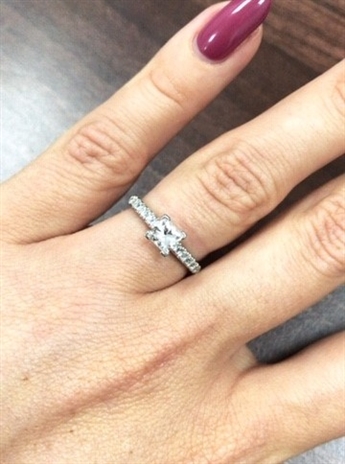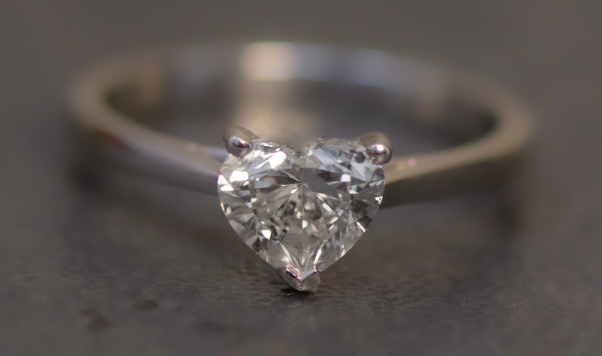Is an Emerald Engagement Ring right for you?
Should you use the distinct green hue of an emerald when proposing? We explore the pros and cons in our latest article.
When dreaming of your perfect engagement ring, emerald may not be the first gemstone that springs to mind. Often, a crystal clear sparkling diamond is at the top of the list - but should more people choose something different when they decide to pop the question?
In recent months there has been a dramatic increase in the number of emerald engagement rings being sold. Despite the distinct green jewellery being able to trace its roots all the way back to the ancient world, it has not always been a popular choice for engagement rings. Today we’re looking at why more people seem to be choosing them and asking whether you should be one of them.
Emerald Engagement Ring meaning
Each precious gemstone has its own meaning that has been developed and adapted over the years. The allure of an emerald comes from its bright green hue that provides a standout feature for any item of jewellery.
As the use of emeralds can trace its history back as far as ancient Greece and the Roman empire, they have deep meaning with many different interpretations. These are some of the most fascinating beliefs that surround emeralds from throughout history:
Spirituality
For as long as anyone can remember emeralds have been considered a symbol of love and truth. The Romans and Greeks believed emeralds to be the gemstones of Venus and Aphrodite respectively, the goddesses of love, passion and desire.
Similarly, the Egyptians viewed emeralds as a source of eternal life - quite a way to mark a proposal! The Incas, too, revered emeralds and treated them as a highly sacred stone of intuition, associated with wisdom and insight into future events.
The emotions of an Emerald
While it’s true that rubies are considered the gemstone of love and passion thanks to their vivid red hue, emeralds are also considered a stone of love. Their green colouring represents new beginnings and vitality, particularly in the spring season.
It is also believed that emeralds have the power to reveal true love, bringing partners closer together. Rubies may symbolise passionate love, but it is emeralds that represent a deep, faithful love for a partner. This is one of the main reasons why emeralds make such good engagement rings, but also why they are suitable for other pieces such as a promise or eternity ring.
WELLNESS
Harking back to the ancient Egyptians and their belief that emeralds represented eternal life, these gemstones are considered by many to bring peace to both the mind and body. Their green illumination is also believed to provide soothing energy, generating vitality within the wearer along with mental clarity and improved focus.
In the past emeralds have even been used in medicine. To treat the eyes, for example, emeralds were soaked in water overnight, this water was then poured over the affected eyes as treatment. They have also been used to treat organs such as the kidneys and pancreas.
Is Emerald ok for an Engagement Ring?
These days more unconventional engagement rings are becoming more and more common. While the traditional princess cut diamond rings are still by far the most popular, the popularity of emerald and other gemstone options is on the rise.
Benefits of an Emerald Engagement Ring
Emeralds are highly versatile stones that work with a wide variety of settings and designs. This allows the brilliant green hue of an emerald to be used in both traditional and more modern engagement rings.
They are also typically less expensive than diamonds meaning they are a more affordable choice when looking for your perfect piece. Despite their lower price, emeralds offer an excellent investment as they hold their value well over time. This makes them a great choice if you are looking to potentially pass your ring on to future generations.
As we have established, emeralds are much less commonly found in engagement rings, making them a unique choice. This is a great way to tailor your proposal to your partner if they prefer the statement that comes with such a non-traditional choice.
Drawbacks of Emerald Engagement Rings
There are several negatives to be aware of when weighing up the possibility of an emerald engagement ring. The most obvious of these is their durability. When comparing emeralds with other gemstones like rubies, sapphires and diamonds they have a much lower Mohs rating; typically between 7.5 and 8.0. This puts them at an increased risk of fracture.
Due to their lack of strength, emeralds have to be cleaned more regularly than other stones. They also usually require hand cleaning, rather than being put into an ultrasonic machine.
Emeralds also tend to have many more inclusions than other precious stones. Inclusions are technically imperfections that are factored in when valuing the stone. For some, they may want fewer inclusions, but for others, they add character and charm to their ring.
While these are issues to take into account, they have a minimal effect on the visual appearance of the final ring.
Emerald Stone or Emerald Cut?
One thing to take into account when deciding on your engagement ring is that an ‘emerald cut’ does not necessarily refer to an emerald stone. An emerald cut diamond is a specific shape of diamond that is popular with engagement rings. With an emerald cut, the diamond is a rectangular shape with the corners cut off. Be sure to bear this in mind when shopping for your ring.
Emerald Engagement Rings from Diamond Heaven
If the meaning of emerald engagement rings appeals to you and you like the idea of breaking from tradition, then this beautiful gemstone could be for you. We have a huge range of emerald engagement rings and even offer customers the ability to design their own using our custom ring builder.
If you’re unsure where to start or would like our professional help, please feel free to book an appointment with one of our jewellery specialists who can guide you through the process.


 Twitter
Twitter
 Famous Princess Cut Engagement Rings
Famous Princess Cut Engagement Rings The Meaning Behind A Solitaire Engagement Ring
The Meaning Behind A Solitaire Engagement Ring Things to Consider When Buying a Heart-Shaped Diamond Engagement Ring
Things to Consider When Buying a Heart-Shaped Diamond Engagement Ring Why Lab Grown Diamonds Make Ideal Christmas Engagement Rings
Why Lab Grown Diamonds Make Ideal Christmas Engagement Rings 